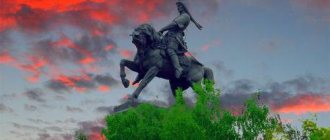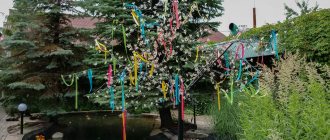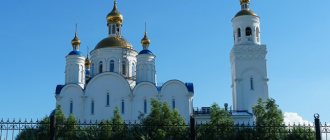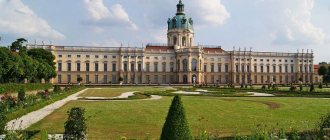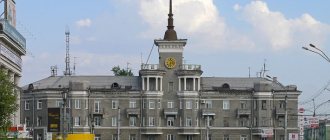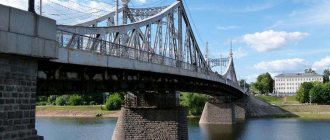History of the Kursk region
History of the Kursk region. Middle Ages.
Since the 1st millennium BC. e. The east of the region was nomadic and pastoral, while the west was sedentary and agricultural. It was the same in subsequent centuries, both during the era of Kievan Rus, and later, until the second half of the 2nd millennium: steppe nomads lived east of Kursk, settled agricultural Rus' lived to the west. The first border between them passed along the rivers Snova, Tuskar, then through Besedino and Oboyan. Here was also the first line of Slavic-Russian fortresses, most of which were settled on ancient settlements dating back to Scythian times. These fortresses were created by the Slavs of the Northern Union at the end of the 8th - beginning of the 9th century.
Since 882, the Seversk land, including the entire west of the Kursk land, became part of the united Old Russian state. And since then, for many centuries, Kursk “towns” and Kursk warriors - kmeti - stood as a frontier shield between Russia and the steppe, taking on the first blows of first the Khazars, then the Pechenegs, and the Polovtsians. This forced the princes to constantly worry about strengthening the lines of border fortresses. In the region, such lines stretched along Tuskar (the settlements of Kurskoye, Shuklinskoye, Pereverzevskoye, Svobodenskoye), along the Seim (Lipinskoye, Korobkinskoye, Artyushkovskoye, Yurasovskoye, etc.), along Kuritsa (Gnezdilovskoye, Northern Nartovskoye), along Svapa (Ratmanskoye, Starogorodskoye, Moiseevskoye , Krasny Kurgan, Mukhinskoye), along Psl (Oboyanskoye, Gochevskoye, Gornalskoye, Sukhodolskoye, etc.). In total, at least 60 Slavic-Russian settlements arose on Kursk land in the 8th - 9th centuries.
The fate of these fortress-fortifications developed differently. Some of them were abandoned by our ancestors and deserted even before the Mongol-Tatar invasion, others in the era of Kievan Rus turned into fortified estates of feudal lords, others remained border fortresses until Batu's defeat. And only a few became real cities.
Only two pre-Mongol cities have survived to this day: Rylsk and Kursk.
Rylsk is repeatedly mentioned in the chronicle, starting in 1152. It was the center of the small Rila principality. Archaeological exploration on Mount Ivan Rylsky, which is located in the city itself, showed that Rylsk as a fortified settlement arose in the 1st millennium BC. e. It was revived as a Slavic fortress at the end of the 8th century. When the fragmentation of Kievan Rus began into a number of independent principalities, Rylsk and the Rylsk principality became part of the larger and independent Chernigov, and then the Novgorod-Seversky principality. During the Mongol-Tatar yoke, the Rila principality and the Rila princes continued to exist as feudal dependents of the Golden Horde.
We find the first written mention of Kursk in the “Life” of a major political and church figure in Kievan Rus, written before the Mongol-Tatar invasion, Theodosius of Pechersk.
As can be seen from the Life, Theodosius came to Kursk with his father as a child. At this time, in Kursk there were already markets, bakeries, feudal lords and a ruler (prince or princely governor). There were brick churches. The Life describes a picture of an already formed ancient Russian city.
It is known for certain that Theodosius died in 1074. The Ustyug chronicle reports that Theodosius died at the age of 82. This means that he was born in 992, and, therefore, came to Kursk at the end of the 10th century.
There are other ancient mentions of pre-Mongol Kursk in chronicles. But there were doubts as to whether it was in the same place where it is now, or whether it was transferred here in later times.
Nowadays, numerous archaeological finds have proven that Kursk from time immemorial stood where it is now. This, in particular, is evidenced by the large number of pieces of glass bracelets found within the city. Such bracelets were worn only in pre-Mongol Kievan Rus, and only by city women. And the very name of the city “Kursk”, clearly derived from the name of the Kur River, shows that it would be unreasonable to look for it on another river.
In two places within the boundaries of Kursk, accumulations of plinth - a special form of pre-Mongol ancient Russian brick - were discovered. Plintha was made only in cities and was used exclusively for the construction of city churches. By the way, the plinth found in Kursk dates back to the 10th century. This means that in the second half of this century Kursk was certainly already a real city. And we can celebrate the millennium of our glorious warrior city.
As a city, as the center of the Kursk principality, Kursk, since the feudal fragmentation of Kievan Rus, was under the rule of the Chernigov, Pereyaslav, and even distant Suzdal princes. And the people of Kursk, like the inhabitants of other principalities, were constantly involved in strife between the princes.
At the beginning of the 13th century, Kursk kmets, as part of Russian squads, heroically fought the Mongol-Tatars in the Battle of Kalka.
The chronicles do not speak about the fate of Kursk and the Kursk people during Batu’s invasion. But archeology told about it. Several years ago, when laying a gas pipeline, the southern part of Red Square was cut through a deep trench. In a trench, at a depth of about one and a half meters, a huge accumulation of bones and skulls of adults and children was discovered. The length of the bone is more than 10 meters, thickness - up to half a meter. It could only be a mass grave of victims of the Mongol-Tatar invasion.
History knows that the Mongol-Tatars exterminated all adults and children in those cities that refused to submit to the invaders and offered armed resistance to them. Proof of precisely this heroic resistance is the terrible bone mound on Red Square in Kursk.
Kursk during the Russian Empire
However, already in 1727 Kursk was included in the Belgorod province. But in 1779, under Catherine the Great, this province was disbanded, and the city became the center of the Kursk governorship. Its first head was the famous Field Marshal Rumyantsev. In 1781, there was a big fire in the city, after which it began to be rebuilt. In 1797, the viceroyalty was transformed into a province. From then on, Kursk became a provincial city.
With the expansion of the borders of the Russian Empire, Kursk loses its significance as a border city, but trade is intensively developing in it. The city grew and expanded, industry began to actively develop in it, and a gymnasium was opened in 1808. The history of Zarechnaya Street is connected with the expansion of Kursk across the river. The city of Kursk has become a fairly large regional center. In the second half of the 19th century, centralized water supply appeared and tram traffic was opened.
Soviet times
In the first quarter of the 20th century, the history of the city of Kursk changed dramatically. A brief summary of the events of those times is that at the end of 1917, Soviet power came to the city. However, this was only the beginning of the Civil War. In September 1919, Kursk was captured by the White Army of General Denikin, but in November it was recaptured by the Red Army. Since then, the city became part of Soviet Russia, and then the USSR.
In 1928, the Kursk province ceased to exist. Kursk became the administrative center of one of the three districts of the Central Black Earth Region, and since 1934 the central city of the Kursk Region.
During the Great Patriotic War, the city was occupied by Nazi troops in November 1941, although it was defended not only by the army, but also by the militia. The liberation of the city took place a year and a half later - in February 1943. In July and August, one of the largest battles of World War II took place near Kursk - the Battle of Kursk.
A year after the liberation, Kursk began to be restored, although the war was still ongoing. In 1953, trams began running along the city streets. Plants and factories were restored in the city.
Up ▲ — Reader reviews (2) — Write a review ▼ — Print version
| e-mail, city: Krasnodar | |
Very interesting and informative. Thank you, I'll be happy to read the sequel.
| Klimkov Sergey Valentinovich | 4 June 2022, 16:07:29 |
| e-mail, city: Vladimir | |
settlements in the northern and central parts of European Russia appeared a very long time ago. This is evidenced by the Vladimir Sungir, which, by the way, has not been fully explored due to the development of the city in the area of the village. Kind. All the same, they were probably not yet Slavs in the form that most ordinary people now understand, but they were (I’m talking about the Kuryans) people who laid down the gene pool of the Slavs along with the tribes living on the territory of Novgorod and Pskov. Arkhangels, Suzdal.
The significance of the history of Kursk
To understand the modern inhabitants of a particular locality, you need to study its history. The past and the present constantly flow into each other, forming a continuous chain of events. Everything that happened today was built on the foundation laid yesterday. That is why the history of the city of Kursk is so important. A summary for children and adults of the historical events that took place in this city is outlined above. But, undoubtedly, this is not enough if you want to learn about Kursk in more detail. The article outlines only the main historical milestones. And for a closer study it is necessary to use mainly primary sources.
According to the educational program, the history of the city of Kursk for grade 2 is included in lessons on the surrounding world. Of course, this helps to familiarize children with the past of their hometown. But adults should not forget about the history of their region. Moreover, residents of other Russian cities should also be interested in events that occurred in various localities of the country in the past. After all, from such pieces of the mosaic the history of our entire homeland is formed into a single whole.
Forgotten villages: secrets of the Kursk region
Exclusive
The places where Fet and Tchaikovsky walked, the settlements of Old Believers, a spring with miraculous healing powers... Just 40 km from Kursk, they became undeservedly forgotten and abandoned.
— Have you already been to Donskoy? - Alexey Lyamin, assistant rector of the local church, asks me.
- Not yet.
- Must go!
“We have to go,” I agree, mentally imagining snow drifts and off-road conditions. This summer is a good time to travel outside the city, enjoying the greenery outside the window. And in winter you never know in which snowdrift your car will get stuck.
It’s not far from Donskoy, a little less than 50 km towards Zolotukhino, passing the town of Svoboda. To get to the village, you need to turn left from the highway to the village of Solnechny. The road is dirty, KamAZ trucks are crawling towards you one after another. There is a sugar factory in Solnechny, the smoke from its chimneys is visible from afar. A village with apartment buildings grew around the plant. But work at the plant is seasonal, and within a few days there will be no smoke.
And the village is classic Soviet: gray panel houses, empty swings, a skimpy “Barbershop” sign on the outbuilding with gloomy metal doors. But there is a school, a kindergarten and even a hospital. Previously, there were a lot of people and a lot of work in Solnechny, the village flourished. Now it’s much less, production volumes have fallen, and the environment has deteriorated. In 2013, due to non-functioning treatment plants, there was a large-scale discharge into the river, and many fish died. Even visitors to Korennaya saw rotten fish.
From Solnechny to Donskoy - along the dirt road. But I’m not looking for easy ways, I make a wrong turn and drive past garages and snow-covered vegetable gardens, along an icy track. Locals carefully follow the car with non-Kursk license plates. Donskoye suddenly emerges from around the bend. There are no people around, and there is no one to even ask where the very temple is, which in 2013 caring people began to restore on their own. But when I turn around, I see the dome of the church and head there.
The houses in Donskoy are quite good and strong, but there are not many of them. Near the church there is ankle-deep snow, it’s clear that people don’t come here often. A shaggy dog greets me with a bark. Struggling hoarsely, she swears at the uninvited guest until I hide behind a wooden wreck. There, behind a rickety barn, an ancient well has been dug, and an alley with snow-white birch trees goes into the distance.
Despite the barking of the dog, no one comes out of the house next to the temple, and the church itself appears deserted. I pull the handle and it’s locked. This temple has a history of 122 years.
The Temple of the Conception of Righteous Anna was built here in 1896.
“The temple is unique in its location,” Alexey Lyamin, with whom we talk on the eve of my trip, tells me. — It is 40 km from Kursk, 12 km from Korennaya Hermitage. According to legend, a married couple lived here who could not have children. The couple made a vow to God and promised that if he would send them a child, they would build a temple. Soon a girl was born, who was named Maria in honor of the Virgin Mary. The couple kept their word and built a temple named in honor of the conception of the righteous Anna.
Before the revolution, the village of Donskoye was part of the Ukolovskaya volost of the Shchigrovsky district. The same volost included the famous 1st Vorobyovka, where Afanasy Fet lived and worked ("Evening Lights" was written here), Ukolovo - where the Tchaikovsky estate was located. The great composer Pyotr Ilyich Tchaikovsky himself often visited his brother here; in Ukolovo, for example, Symphony No. 6 and “Iolanta” were written.
Here, in the Ukolovskaya volost, were located the Old Believer villages of 2nd Vorobyovka, Nikulino, Reutovo. The Old Believers, persecuted for their services, moved, among other things, to the Kursk region, where they were more loyal to the adherents of the old charter. According to legend, the village of Donskoye also bears its name for a reason. One of the Old Believers came from the Don Cossacks, and it was at his suggestion that the place received its name. The Cossacks took a fancy to the village.
During Soviet times, the domes and bell tower of the temple were destroyed.
— Another feature of the temple is two thrones: in honor of the conception of the righteous Anna and in honor of the Donskaya icon.
In 2013, Father Oleg was appointed rector of the temple. A team of like-minded people began to come here with him.
“First we installed the dome, then a new foundation, because the building was collapsing,” says Alexey Lyamin. — We went to different organizations and asked: who will give how much. Since 1992, the temple has not been painted, we painted it and put it in order. Locals rarely come here; they only come from the city on Parents’ Saturday. There are barely a hundred people here in the area. It’s amazing, of course, that 10 km away in Svoboda there are fairs going on with grandeur and pomp, but here a forgotten village is slowly dying and falling into disrepair. It's a show there, but here everything is very bad.
Alexey and other Cossacks, who are today restoring the temple in Donskoy, became interested in the history of these regions in 2004. It all started with a wooden church in Ukolovo. Afanasy Fet and his wife Maria Botkina and Nikolai Tchaikovsky once prayed here. Miraculously, this temple was not damaged during Soviet times. Apparently, due to the fact that there is no asphalt road to it, but only a dirt road. Alexey shows me photographs taken in Ukolovo in the summer.
Maria Botkina was a religious devotee and attended the Ukolovsky church, and was the godmother of peasant children (she never had her own). Afanasy Fet was friends with the prince-poet Konstantin Romanov. And Maria Petrovna’s nephew was martyred with the royal family.
This is what the ancient temple in Ukolovo looks like now
The temple in Ukolovo was restored for a long time and also by the efforts of caring people.
Donskoy has its own history, and, according to those who work in the church, its own destiny.
“We want to make Donskoye an old Russian settlement, where people will live according to ancient traditions. After all, throughout Russia there are a lot of people who are tired of urbanism and megacities; they can come here. Our country already has such corners, but not yet in the Kursk region. We want to revive the Old Believers here, because Seraphim of Sarov told the Old Believers that their faith is a boat on a rope near a large ship of Orthodoxy. Today, it is the Old Believers who are the bearers of the Russian cultural code.
- Today we are empty, we have lost our connection with traditions. The Russians were left without a home. And by reviving our culture, we return home. We will soon have no land of our own; all Kursk land has been sold to Muscovites.
In 2nd Vorobyovka, a school was made from an ancient wooden Old Believer church; there are no more than 15 students here. The village itself looks depressing - dilapidated houses, old people living out their lives here.
The Old Believer temple has been preserved only in drawings
There is a school here now
Alcoholism is a sure companion of unemployment in villages
— How to get to 2nd Vorobyovka? — I ask a resident in Donskoy. A woman washes clothes near a well.
- Why do you need to go there?
— I wanted to see the temple.
- Honey, the temple has been gone for a very long time. There is a school there now, before this there was a stable. We also have an ancient church in Donskoy.
A five-minute walk from the Church of the Conception of Righteous Anna there is a cross, I go down lower and see the source. A man is sitting near the water, and next to him are two bags with empty bottles.
— Are you from Donskoy?
— No, I’m from Solnechny. We used to go to Korennaya for water, but then my grandson found this source, tried it, and the water tastes better than in Korennaya. Now I walk here, it’s about three kilometers.
“This is a difficult source,” Alexey Lyamin tells me. — I’ve been here since 2013, and during this time there have been 15 cases of healing from infertility. When doctors shrug their shoulders, and women come to us, pray in the temple, drink water from the source and soon give birth. And children were brought here, and the children were healed. These are places with incredible energy.
I carefully go down to the source and take ice-cold water in my palms, it’s really tasty. There is ringing silence all around. Amazing places with their own stories, secrets and riddles.
Nadezhda SURGINA.
Popular message topics
- Atmosphere
The atmosphere is a volume of gas that consists of different mixtures; on earth they are considered air. The air itself consists of oxygen molecules and with the greatest participation of nitrogen. A small percentage is shared by other gases - steam, - Luxembourg
Luxembourg is one of the smallest states in Western Europe. Has the status of a grand duchy. The capital is the city of the same name. The population is about 600 thousand people, almost half of whom are foreigners. Official language - Properties of ice
Every person has seen ice at least once in his life. But not everyone knows at what temperature ice begins to melt, where there is most ice on the planet and what properties it has. Today we will try to find out a little more about this cold and slippery substance.
